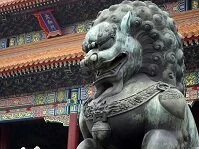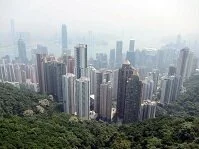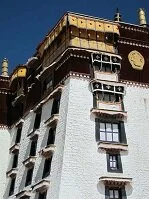
Forbidden City
The Yuan Dynasty (1271-1368) left almost nothing behind, including the loss of the Great Palace of Kublai Khan, which was placed in the country's new capital, Beijing. Of the few remains, the Drum Tower and the Whit Pagoda in Beijing are both from this rule.
The Ming Dynasty (1368-1644) built many buildings that survive to the present, including the Forbidden City in Beijing (begun in the 1400s), which is one of the most impressive and densely built upon lands in the country. Every structure is monumental in detail, technique, and often also in size as it contains nearly 9,000 rooms and was home to the Emperors for years. This time period also represented a shift to heavily painted buildings, which is impossible to miss in the Forbidden City. The Ming Dynasty also built the Temple of Heaven (1500s; rebuilt in the 1890s), which is an all wood circular temple built upon a square marble base; this building contains no nails and is again heavily painted.
The Qing Dynasty (1644-1911) built relatively little although they regularly updated numerous buildings, including the Forbidden City. They also built the Emperor's Summer Palace (1700s) in Beijing (although at the time it fell outside the city walls). The Qing Dynasty was also well known for creating gardens a part of their landscape and integrated it strongly with their architecture to work with buildings.

Hong Kong
With the communist takeover in China following World War II the architecture has changed dramatically, with the greatest change being the loss of numerous historic pieces. Under Mao the government demanded that thousands of pieces of architecture be destroyed during the Cultural Revolution. The buildings erected in their place have generally been simple factories or housings units that are focused on efficiency and use over aesthetics.

Potala Palace
However, for much of this time Hong Kong and Macau remained outside Chinese power and their architecture better reflects their rulers than it does China. Macau was ruled by Portugal and there are significant indications of this past relationship. Hong Kong was ruled by the British and grew into a massive modern city as it boasts some of the country's finest modern and post-modern architecture with a modern skyline that competes with New York and the best of the world.
A final note about the massive country's architecture is that the ethnic Chinese were not the only rulers of every part of China as its borders stand today. Numerous ethnic groups controlled various parts of the modern country in the past and these regions reflect the local people and their architecture, not China's. For this reason there are numerous alterations on Chinese architecture and in some places a completely different style. However, these people rarely built structures that have lasted or are noteworthy; the exception to this though is Tibet. The Tibetans have a unique architecture not seen elsewhere in China and this is best represented by their masterpiece, the Potala Palace (1649) in Lhasa.